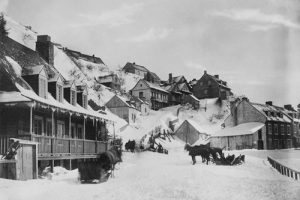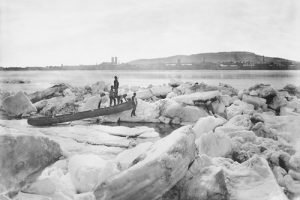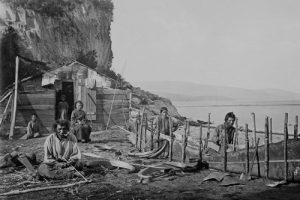Alexander Henderson Photography Exhibit – until April 16, 2023
McCord Stewart Museum presents
Alexander Henderson – Art and Nature
A contemplative journey to the heart of majestic Quebec and Canadian landscapes
Until April 16, 2023, the McCord Museum is presenting Alexander Henderson – Art and Nature, the first major exhibition devoted to Alexander Henderson (1831-1913). Visitors are invited to marvel at the vast natural spaces and fascinating urban scenes of the 19th century the photographer captured over the course of his career, from his early excursions into the area surrounding Montreal, to his trips to the furthest reaches of Quebec and travels to Western Canada. Though his work was later forgotten for many years, Henderson became one of the country’s leading landscape photographers, creating images reminiscent of the picturesque compositions of the great masters.

Alexander Henderson – Art and Nature features over 250 period prints and reproductions of photographs, in addition to documents and photo albums from the photographer’s personal archives. The public will discover striking, Romanticism-infused images taken during his many travels: canoeing on Laurentian rivers, Indigenous fishing camps on the Restigouche River, and the majestic Saguenay fjord. Though known for his photographs of the great outdoors, Henderson also took numerous photos of city scenes depicting the Montreal of the past— views of Mount Royal, ships docked in the harbour and downtown flooding.
“Henderson is a profoundly Romantic artist. His work conveys the emotions he felt faced with the beauty of nature—the metaphysical awe it inspired. His attention to detail and the sensuality of the environment, whether rural or urban, distinguished him from other photographers of the era, such as Notman, who focused more on commercial expectations,” noted Hélène Samson, the exhibition’s curator and outgoing Curator of Photography, McCord Museum.
Henderson demonstrates a real affection for Canada’s winters, which seem to have provided him with much inspiration while also requiring him to adapt to the challenges of taking photographs in snowy and frigid conditions. His winter scenes—the aftermath of a snowstorm, tobogganing at Montmorency Falls, ice shoves on the Saint Lawrence, and especially the marvellous images of frost and ice captured at Niagara Falls—possess a splendour that sets him apart from his contemporaries. In addition, the photographer’s correspondence, quoted throughout the exhibition, immerses visitors in the land and the lifestyle of the time. As he wrote from Montreal to John Elder on June 7, 1856, “Three friends and myself were away this week, two days, on a fishing expedition to the Chateauguay Lakes, but bad weather and rather poor sport – the scenery is beautiful like some of our highland lakes only the hills covered with forest to their tops – the land is poor and out of the way up there, so that it is a perfect wilderness.”
A Scotsman in Canada
A scion of the Scottish landed gentry, Alexander Henderson immigrated to Montreal in 1855. The grandson of the first chairman of the National Bank of Scotland and the son of a prosperous merchant, he was independently wealthy and became part of Canadian society’s privileged class upon his arrival. This financial security enabled him to pursue his new passion of photography.

Henderson had been acquainted with photography in Scotland, but it was in Montreal, around 1857, that he learned the technique, very likely from William Notman (1826-1891). The two men, who shared an interest in the arts, were among the small group of influential figures who attended a meeting in 1860 that would result in the creation of the Art Association of Montreal (now the Montreal Museum of Fine Arts).
Henderson’s prolific period from 1859 to 1865 saw the emergence of a genuine artistic vision as he strived to create images that rivalled the paintings and photographs he must have seen in his family home and at London’s Great Exhibition of 1851. Eager to have his work recognized, Henderson submitted exceptional photographs to competitions in several international exhibitions, including those held in New York in 1877 and 1878, where he earned two first prizes in the landscape category.
He ran a photography studio on Phillips Square from 1866 to 1874, where he took portraits of a clientele composed largely of fellow European immigrants before becoming exclusively a “landscape photographer.”
In the latter part of his career, he photographed major national projects for railway companies. It was during this period that he travelled to Western Canada, where he captured the majestic views of the Rockies that are also part of the exhibition.
Colonization and cultural bias
The exhibition also examines the colonial vision evident in Henderson’s work. After all, his privileged position as a British immigrant in the Canadian society of the time helped shape his observations of both places and people. Some eloquent examples of this are his keen interest in historical buildings and traditional occupations, his photographs of major national projects for railway companies, and his disregard of certain subjects, such as French Canadians.

Although there is no indication that Henderson wished to understand the Indigenous people he so frequently photographed, he did represent their realities without artifice, unlike his contemporaries who would romanticize them to satisfy the interests of their bourgeois clientele. Despite the distance that he maintained, Henderson may have felt a certain admiration and curiosity for his Indigenous subjects. Above all else, however, there was a sense of urgency to document and preserve some traces of the lives of these communities. After all, the colonists believed that the Indigenous peoples’ failure to adopt the European lifestyle would lead to their extinction.
“This exhibition is an opportunity to approach the work of a 19 th -century artist from a contemporary perspective. As part of the Museum’s decolonization process, we want to raise awareness of cultural bias and thereby use the Museum’s collections to take a critical, clearheaded look at history,” explained Suzanne Sauvage, President and Chief Executive Officer of the McCord Museum.
From recognition to anonymity
Despite enjoying a prolific career as a photographer for several decades, Alexander Henderson completely abandoned the medium in his later years and his obituary made no mention of his practice as a photographer. This omission continues to mystify Henderson experts to this day. The McCord Museum is pleased to offer lovers of history and photography access to this exceptional record of the history of Montreal and Canada. The Museum’s collection of photographs by Alexander Henderson, the largest in existence, consists of nearly 2,000 period prints, complemented by his personal archives. It is especially precious since virtually all of the photographer’s glass negatives—the raw material of his practice—were destroyed. Only twenty or so remain, preserved at the McCord Museum and the Musée national des beaux-arts du Québec. It is believed that the surviving prints represent only a fraction of his total output.
For opening hours and to purchase your tickets visit: www.musee-mccord-stewart.ca






